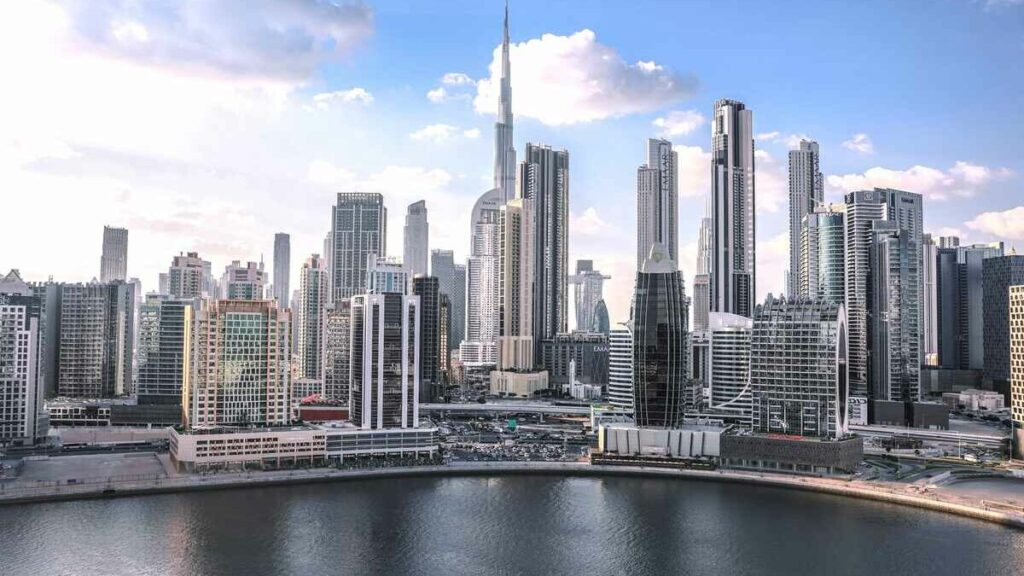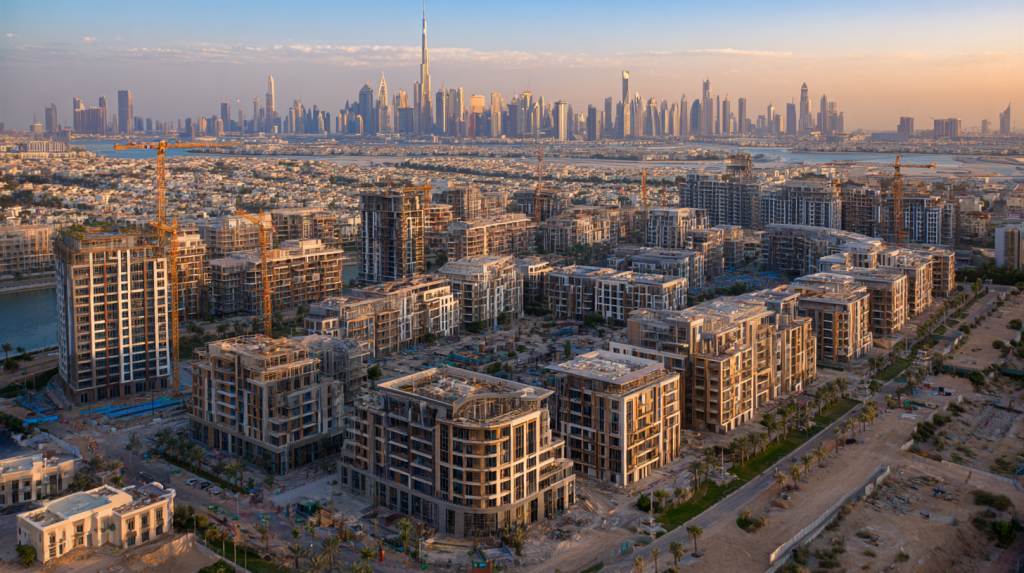The UAE property market is preparing for one of its most transformative phases in recent history. According to Moody’s Ratings, the introduction of over 150,000 new homes into the market between 2025 and 2027 is expected to lead to a modest correction in property prices starting in 2026. While some might interpret this as a downturn, the reality is far more nuanced. For buyers, renters, and investors, this change opens the door to new opportunities, more balanced market dynamics, and a healthier overall real estate environment.
Dubai, Abu Dhabi, and other emirates have witnessed remarkable growth in property prices over the past decade. Rising demand, fueled by population growth, international investment, and the UAE’s economic diversification strategy, has driven prices to record levels. However, the market is now entering a stage where supply will catch up with demand, providing a more sustainable and predictable property landscape.
Surge in Housing Supply Across Emirates
The most significant factor contributing to this transformation is the surge in housing supply. Over 150,000 new residential units are expected to hit the UAE property market in the next few years. Dubai alone is projected to see a 20% increase in housing stock, with a mix of apartments, townhouses, and villas becoming available to buyers and renters alike.
This increase in supply comes at a critical time. Demand for housing has remained strong, but rising prices have made it challenging for new buyers and young professionals to enter the market. The addition of new homes offers potential relief, allowing buyers to find homes at more competitive prices and providing renters with a wider range of choices.
The distribution of these new units will be spread across key developments and emerging areas. Developers are focusing on creating communities with modern amenities, sustainable living solutions, and convenient access to transportation hubs. These factors will enhance the attractiveness of new properties, even in a market that may see a slight overall price correction.
Population Growth and Sustained Demand
Despite the influx of new homes, demand for real estate in the UAE is expected to remain robust. Dubai’s population alone has grown by 6% in 2024, reaching nearly 4 million residents. Economic growth, job creation, and visa reforms aimed at attracting global talent have fueled this increase.
Moreover, household sizes are shrinking. Average household sizes have declined from 4.4 individuals in 2019 to 3.9 today. Smaller households drive demand for additional housing units, particularly one- and two-bedroom apartments and compact villas. This trend means that even with the addition of thousands of new homes, the market is unlikely to experience oversupply in high-demand areas.

Opportunities for Buyers
For buyers, the anticipated market correction is a welcome development. Increased supply often translates into more competitive pricing, giving buyers greater leverage to negotiate favorable deals. Those who have been waiting for the right moment to enter the market may now find that conditions are more favorable than ever.
Additionally, the diversification of available housing options ensures that buyers can find properties that meet their lifestyle needs. From luxury apartments in iconic city towers to affordable townhouses in emerging communities, the UAE property market is becoming increasingly accessible. For first-time buyers, this could be the perfect time to invest, secure favorable mortgage rates, and benefit from long-term property appreciation.
Benefits for Renters
Renters stand to gain significantly from this market shift as well. The addition of thousands of new homes is likely to stabilize rental prices, which have seen substantial increases in recent years. A larger supply of units can reduce competition for desirable properties, allowing renters to find homes that meet their needs without paying excessive rents.
Families, young professionals, and expatriates looking for long-term rental solutions will find themselves with more options than ever before. Moreover, developers are placing a strong emphasis on creating communities with amenities such as parks, gyms, and retail centers, further enhancing the living experience for tenants.
Investor Perspective: Balanced and Strategic
Investors may initially view the surge in supply with caution, concerned about potential oversupply and its impact on returns. However, the continued demand from a growing population, coupled with economic stability and strategic urban planning, suggests that the market will absorb these new units without significant negative effects.
Savvy investors are likely to focus on areas with strong infrastructure development, high-quality amenities, and strategic locations. Properties in well-planned communities, close to transportation networks, commercial hubs, and educational institutions, are expected to retain their appeal and value. Long-term investors who adopt a strategic approach may even find new opportunities in areas poised for growth.
Government Initiatives Supporting Market Stability
The UAE government has played a proactive role in ensuring the stability and resilience of the property market. Initiatives to diversify the economy, attract foreign investment, and develop infrastructure have created a conducive environment for real estate growth.
Programs such as long-term residency visas, incentives for investors, and policies promoting sustainable development have strengthened market confidence. These measures provide assurance to buyers, renters, and investors that the UAE property market is well-regulated and poised for healthy growth.
Emerging Trends in UAE Real Estate
Beyond supply and demand dynamics, several trends are shaping the future of the UAE property market. Sustainable and green building practices are becoming increasingly prevalent. Developers are incorporating energy-efficient designs, smart home technologies, and environmentally friendly materials to meet the growing demand for sustainable living.
Additionally, mixed-use communities that integrate residential, commercial, and recreational spaces are gaining popularity. Residents are seeking more than just a home; they want communities that offer convenience, lifestyle amenities, and opportunities for social interaction.
The luxury segment is also evolving. Buyers are increasingly looking for properties that combine premium finishes, smart technologies, and access to exclusive amenities. Developers are responding with innovative projects that cater to the high-end market while maintaining value for mid-range buyers.

Long-Term Outlook: Sustainable Growth
Looking ahead, the UAE property market is expected to enter a phase of sustainable and balanced growth. The interplay between increased supply and sustained demand, combined with proactive government policies, will create a more predictable and stable real estate environment.
Price corrections in 2026 are not necessarily negative; they reflect a market adjusting to new supply levels. For buyers, renters, and investors, this adjustment provides opportunities to make well-informed decisions, invest strategically, and enjoy a more transparent property landscape.
Sustainable growth is likely to benefit all stakeholders. Buyers will find better deals and more housing options, renters will enjoy greater stability, and investors can focus on long-term value appreciation. Developers will continue to innovate, responding to the evolving needs of residents and investors alike.
Regional Implications and Global Investment
The UAE’s property market is not just a local affair; it is a key destination for global investors. Economic stability, political security, and strategic location make the Emirates an attractive hub for international capital. The introduction of new homes, combined with competitive pricing, may draw even more interest from foreign investors seeking opportunities in high-growth regions.
This global interest reinforces the resilience of the UAE property market. Even as prices adjust locally, the market remains integrated into broader international investment flows, ensuring continued liquidity and market activity.
Conclusion: A Positive Era for UAE Real Estate
In conclusion, the UAE property market is entering a new era characterized by increased supply, sustained demand, and balanced growth. While Moody’s predicts modest price corrections starting in 2026, this development should be seen as a positive adjustment that enhances market accessibility and long-term stability.
Buyers and renters will benefit from more choices, competitive prices, and improved community amenities. Investors can focus on strategic locations and long-term value, while developers will continue to innovate to meet evolving demands.
With supportive government initiatives, robust economic growth, and a growing population, the UAE real estate market is well-positioned for sustainable success. The coming years promise a healthier, more dynamic, and opportunity-rich environment for all stakeholders, marking a truly transformative period for the Emirates’ property sector.
Do follow Gulf Magazine on Instagram.
Also Read – Sobha Realty Secures $750M Green Sukuk for Bold Future



